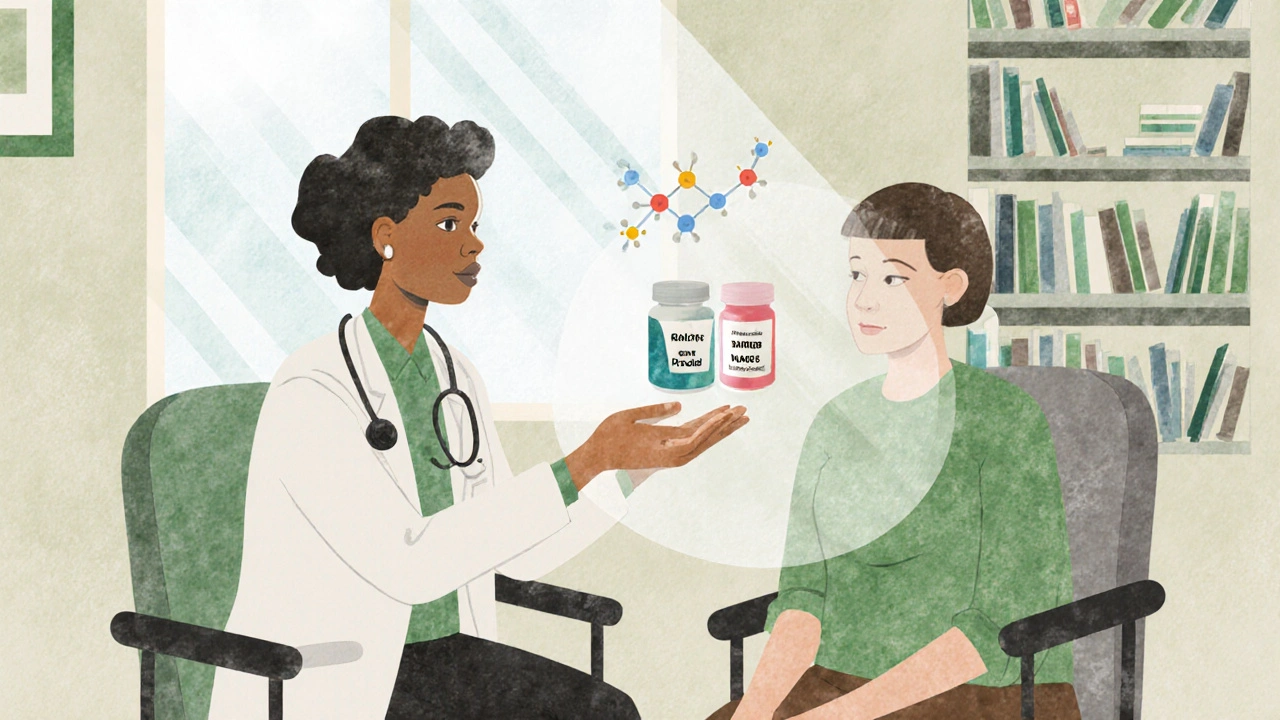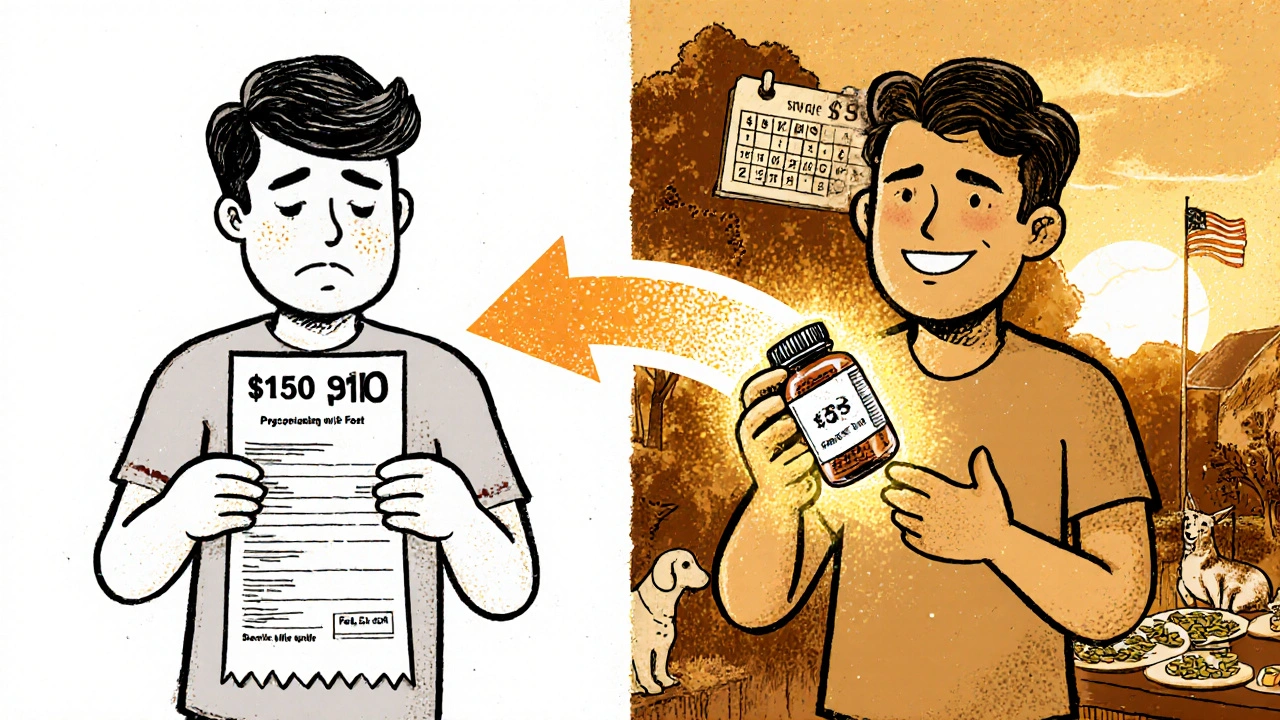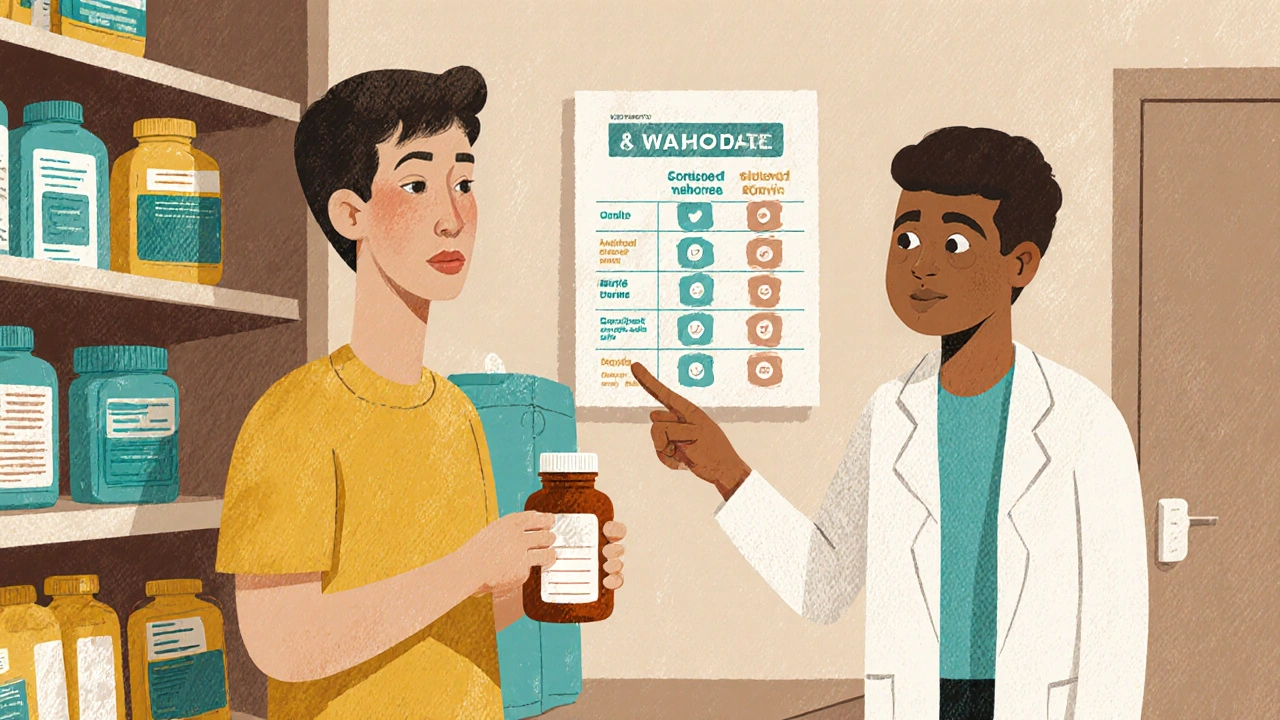Why Your Doctor Might Suggest a Generic Medication
You walk into the pharmacy, ready to pick up your prescription, and notice the pill looks different. The name on the bottle isn’t the one your doctor wrote down. You might feel confused-or even worried. Did they give you the wrong medicine? Is it weaker? Less safe?
The truth is, most of the time, you’ve been given a generic version of your brand-name drug. And it’s not a downgrade. It’s the same treatment, just cheaper. In the U.S., nine out of every ten prescriptions filled are for generics. But that doesn’t mean patients understand why.
Doctors don’t suggest generics because they’re cutting corners. They suggest them because they work just as well-and because the cost difference can be the difference between taking your medicine every day or skipping doses because you can’t afford it.
What Exactly Is a Generic Drug?
A generic drug is a copy of a brand-name medication that contains the exact same active ingredient, works the same way in your body, and delivers the same clinical results. The U.S. Food and Drug Administration (FDA) requires that generics meet the same strict standards for safety, strength, purity, and quality as the original. There’s no loophole. No shortcuts.
Think of it like this: if your brand-name drug is a Toyota Camry, the generic is another Camry made by a different factory. Same engine, same safety features, same fuel efficiency. The paint color might be different. The logo on the hood? Gone. But it still gets you where you need to go.
The FDA’s approval process for generics is called an Abbreviated New Drug Application (ANDA). That doesn’t mean it’s easier-it means the manufacturer doesn’t have to repeat expensive clinical trials. Instead, they prove their version is bioequivalent: it gets absorbed into your bloodstream at the same rate and to the same extent as the brand-name version. The acceptable range? Within 80% to 125% of the original. Most generics fall within 95%-barely a blip.
Why Do Generics Cost So Much Less?
Brand-name drugs are expensive because the company that invented them spent years and millions developing them. They hold a patent-usually 20 years from the filing date-that gives them exclusive rights to sell it. Once that patent expires, other companies can make copies.
Those companies don’t have to pay for research, marketing, or advertising. They don’t need to convince doctors to prescribe it. So they can sell the same medicine for 80% to 85% less. In 2022, generic drugs saved the U.S. healthcare system over $1.67 trillion since 2007. That’s not just a number-it’s real money in people’s pockets.
For you, that might mean a $150 monthly prescription drops to $25. Or your insulin goes from $300 to $40. That’s not a small thing. It’s the difference between managing your condition and putting off treatment because you can’t afford it.
Are There Times You Should Stick With Brand-Name?
For almost every medication, the answer is no. But there are rare exceptions.
Some drugs have a narrow therapeutic index-meaning the difference between a helpful dose and a harmful one is very small. Examples include warfarin (a blood thinner), levothyroxine (for thyroid disease), and certain anti-seizure medications. In these cases, even tiny changes in how the drug is absorbed can matter.
Some doctors still prefer to keep patients on the same brand for these drugs, especially if they’ve been stable for years. But here’s the catch: the FDA says approved generics are just as safe and effective-even for these drugs. Studies show that switching between generic manufacturers of levothyroxine, for example, rarely causes issues. A 2016 study in the New England Journal of Medicine found minor fluctuations in some patients on warfarin, but those findings haven’t been widely repeated or proven to cause harm.
Bottom line: if your doctor says you need the brand-name version, ask why. Is it because of your specific condition? Or because they’re used to prescribing it? Don’t accept “that’s just how it’s always been” as an answer.

What’s the Difference Between Generics and Brand-Name Pills?
Outside of the active ingredient, the only real differences are cosmetic and chemical.
By law, generics can’t look exactly like the brand-name version. So the shape, color, size, and even the markings on the pill will be different. That’s why you might feel like you got the wrong medicine when you pick it up.
They also use different inactive ingredients-fillers, dyes, preservatives. These don’t affect how the drug works. But for people with rare allergies (like to certain dyes or gluten), that can matter. If you’ve ever had a reaction to a pill you didn’t understand, check the label. Ask your pharmacist: “What’s in this?”
Some people report feeling different after switching. That’s often the nocebo effect-when you expect something to go wrong, your body reacts as if it has. One study found that 17% of patients were initially worried when switched to generics. But after a pharmacist explained what was happening, 92% said they were satisfied.
How to Start the Conversation With Your Doctor
It’s not always easy to bring up cost or ask questions about your meds. But you have every right to know your options.
Here’s how to make the conversation simple and effective:
- Ask: “Is there a generic version of this drug?” Most of the time, the answer will be yes.
- Ask: “Will it work the same for my condition?” This opens the door for your doctor to explain any special considerations.
- Ask: “Are there any reasons I shouldn’t switch?” This forces them to justify if they’re recommending the brand-name version.
- Be honest about cost. Say: “I’m worried I won’t be able to afford this every month.” That’s not weakness-it’s practical.
Doctors aren’t trying to sell you expensive pills. Most of them know the financial burden patients carry. If you don’t mention it, they might assume you can afford it.
What to Do If You’re Switched Without Asking
In many states, pharmacists are required by law to substitute a generic unless the doctor writes “dispense as written” on the prescription. That means you might get a different pill without ever talking to your doctor.
If you notice a change:
- Check the label. Is it a generic? Look for the manufacturer name or “generic” on the bottle.
- Call your pharmacy. Ask: “Was this a substitution?”
- Call your doctor. Say: “I was switched to a generic. Is that okay for me?”
If you feel different after switching-worse side effects, less control over your symptoms-don’t ignore it. Write down what changed, when, and how. Bring it to your next appointment. It might be nothing. Or it might be something your doctor needs to know.

When to Trust Your Pharmacist
Your pharmacist is one of the best resources you have. They see your medication history. They know which generics are available. And they’re trained to explain differences in plain language.
According to a 2022 study by the American Pharmacists Association, 78% of patient concerns about generics were resolved after a simple conversation with their pharmacist. That’s huge.
If you’re unsure, ask: “Is this generic as good as the brand?” or “Why does this one look different?” Most pharmacists will pull up the FDA’s Orange Book for you-the official list of approved generics-and show you the data.
What’s Changing in the Generic Market
Generics aren’t static. The FDA has sped up approvals thanks to the Generic Drug User Fee Amendments (GDUFA). In 2012, it took 36 months to approve a generic. Today, it’s down to 10 months. That means more options, faster.
More than 745 generic drugs were approved in 2022 alone. And as more brand-name drugs lose patent protection-like Humira, which just became available as a biosimilar-generics will keep expanding.
But there are risks. Supply chain issues, especially after the pandemic, have caused shortages. Nearly half of all generic drug shortages come from single-source manufacturers. That’s why having a backup plan matters. Talk to your doctor: “If this generic runs out, what’s the alternative?”
Final Thought: It’s Not About Cheap. It’s About Smart.
Choosing a generic isn’t settling. It’s choosing to use a tool that’s been proven safe, effective, and affordable. It’s about making sure you can stick with your treatment long-term.
Brand-name drugs have their place-especially when there’s no generic yet, or when you’re part of a rare group that truly needs the original. But for most people, the generic is the smarter, safer, and more responsible choice.
Don’t be afraid to ask. Don’t assume your doctor knows your budget. Don’t let a different-looking pill scare you. Your health isn’t about the label on the bottle. It’s about what’s inside-and whether you can take it every day without stress.
Are generic medications as effective as brand-name drugs?
Yes. The FDA requires generic medications to have the same active ingredients, strength, dosage form, and route of administration as the brand-name version. They must also prove bioequivalence-meaning they work the same way in your body. Studies show that 89% of patients report no difference in effectiveness after switching to generics. For nearly all medications, generics are just as effective.
Why do generic pills look different?
U.S. trademark laws prevent generic drugs from looking identical to brand-name versions. So the shape, color, size, and markings on the pill are different. These changes don’t affect how the medicine works-they’re only cosmetic. The active ingredient, dose, and effect are identical. If you’re confused by the change, check the label or ask your pharmacist.
Can I ask my doctor to prescribe only brand-name drugs?
Yes, you can ask. But your doctor will likely ask why. If cost isn’t an issue and you’ve had a bad reaction to a generic in the past, they may agree. But for most conditions, there’s no medical reason to avoid generics. If your doctor refuses without a clear reason, ask for an explanation. You have the right to understand the choice.
Are there any medications where generics aren’t recommended?
For most drugs, generics are fine. But for medications with a narrow therapeutic index-like warfarin, levothyroxine, or certain seizure drugs-some doctors prefer to keep patients on the same version to avoid even small changes in absorption. However, the FDA still considers approved generics safe for these drugs. If you’re concerned, talk to your doctor or pharmacist. Don’t assume you need the brand-name version unless there’s a documented reason.
What if I feel worse after switching to a generic?
Write down what changed: symptoms, timing, side effects. Then call your doctor. While most changes are psychological (called the nocebo effect), some people do react to inactive ingredients like dyes or fillers. Your pharmacist can check the ingredients. If your condition isn’t stable, your doctor may switch you back or try a different generic. Don’t ignore it-your feedback matters.
Why do pharmacies automatically switch to generics?
In most U.S. states, pharmacy laws require pharmacists to substitute a generic unless the doctor writes “dispense as written” on the prescription. This is designed to lower costs for patients and the healthcare system. If you don’t want a substitution, ask your doctor to write “do not substitute” or “dispense as written” on the prescription.
How much money can I save with generics?
Generics typically cost 80% to 85% less than brand-name drugs. For example, a $150 monthly brand-name pill might drop to $25 as a generic. The average out-of-pocket savings per prescription is around $45. Between 2007 and 2016, generic drugs saved the U.S. healthcare system $1.67 trillion. For individuals, that adds up to thousands of dollars a year.




Bill Camp, November 20, 2025
Look, I don’t care what the FDA says-generic pills make me feel like I’m taking something my dog could’ve chewed through. My blood pressure went nuts after they switched me. I don’t need some corporate lab’s version of my medicine. I want the real thing. And if I gotta pay more, so be it. I’m not a guinea pig.
swatantra kumar, November 21, 2025
Brooo, generics are the real MVP 🙌🇮🇳 I was paying $300/month for my diabetes med in the US... switched to generic? $18. Same pill, same results. Now I can afford chai and samosas. FDA? More like F***ing Done Right. 💪
Cinkoon Marketing, November 22, 2025
Actually, I read this whole thing and it’s pretty solid, but you missed one tiny thing-sometimes the fillers in generics can cause GI issues if you’re sensitive to lactose or gluten. I had a weird bloating thing for weeks until I checked the inactive ingredients. Always read the tiny print. Also, don’t trust the pharmacist’s word alone-ask for the Orange Book entry. It’s free online.
robert cardy solano, November 24, 2025
Yeah, I’ve been on the same generic for 5 years. Never noticed a difference. My doc said it’s the same chemical. My body didn’t care. The only thing that changed? My wallet stopped crying. Simple as that.
Pawan Jamwal, November 25, 2025
Let me tell you something-India makes 60% of the world’s generics. We don’t cut corners. We build them better. Your ‘brand-name’ drug? Probably made in India. You’re just paying for the American label. The same tablet, same factory, same FDA approval. You’re not buying quality-you’re buying branding. And that’s just sad.
Lemmy Coco, November 25, 2025
i think genercis are great but i just wana say i had a bad experiance once with a generic for my anxierty med and i felt like i was gonna pass out for 2 days and i was so scared but my doc said it was probly the nocebo thing but still… i dont trust them anymore
rob lafata, November 26, 2025
You people are pathetic. You’re all too lazy to demand real medicine, so you swallow corporate trash and call it ‘smart.’ The FDA is a puppet of Big Pharma. You think they’d approve a generic that’s 10% off? They’re not checking bioequivalence-they’re checking your bank account. And you’re happy to be exploited. Pathetic. Wake up.
Matthew McCraney, November 27, 2025
EVERY time I switch to generic, my depression gets worse. I’m not crazy. I’ve kept journals. I’ve seen the dates. The pills look different. The packaging is cheaper. And the side effects? Always worse. This isn’t coincidence. This is a controlled experiment-by the government. They want us docile. They want us dependent. And generics? They’re the gateway drug to pharmaceutical slavery.
serge jane, November 29, 2025
It’s funny how we treat medicine like a consumer product. We think ‘more expensive = better’ because we’ve been trained to. But the truth is, the active ingredient doesn’t care about marketing budgets or logo colors. It just interacts with receptors. And if two molecules are bioequivalent, they’re the same molecule. The fear isn’t about the pill-it’s about surrendering control. We don’t trust systems. We don’t trust science. We trust the story we tell ourselves. And that’s the real cost.
Nick Naylor, November 30, 2025
Generic drugs are not ‘equivalent.’ They are ‘bioequivalent’-a term defined by the FDA under 21 CFR 314.94. The allowable range is 80–125% AUC and Cmax. That’s a 45% window. That’s not ‘same.’ That’s ‘within statistical tolerance.’ And when you’re on a narrow-therapeutic-index drug like warfarin? That’s not a margin-it’s a minefield. The FDA’s approval process is a legal fiction. Don’t be fooled.
Brianna Groleau, December 2, 2025
I just want to say thank you for writing this. I’m from a small town in Mississippi, and I’ve been on levothyroxine for 12 years. I switched to generic twice and felt like I was drowning in fog-tired, heavy, forgetful. I was too scared to say anything because I didn’t want to sound ungrateful. But after reading this, I finally called my doctor. He listened. We switched me back. And now I sleep. I cry when I think about how long I suffered in silence. If you’re reading this and you feel off after a switch-don’t stay quiet. You’re not being dramatic. You’re being human. And your voice matters.